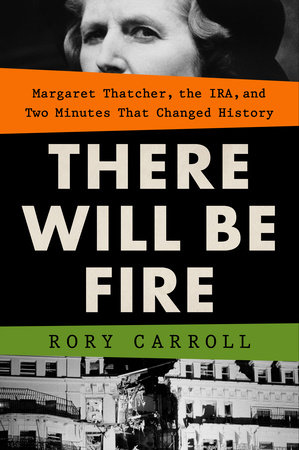There Will Be Fire: Margaret Thatcher, the IRA, and Two Minutes That Changed History
- By Rory Carroll
- G.P. Putnam’s Sons
- 416 pp.
- Reviewed by Todd Kushner
- April 24, 2023
A propulsive account of an audacious bombing in the U.K.

The Irish Republican Army in October 1984 came within a hair’s breadth of assassinating British prime minister Margaret Thatcher during the Conservative Party Congress in Brighton, England. Intricately planned, the IRA operation required meticulous preparation, including two days spent assembling and secreting a bomb in Brighton’s Grand Hotel with a timer set to detonate in precisely 24 days, six hours, and 36 minutes. The resulting blast devastated the hotel, wounded dozens of people, and killed five.
Veteran journalist Rory Carroll draws on hundreds of hours of original reporting supplemented by information from documentaries, memoirs, and contemporary press accounts to provide a gripping narrative of the bombing and the events that precipitated and followed it. He relates the main events so effectively that readers practically live them. He also puts developments in historical context, placing them in the arc of the long, fraught chronicle of Anglo-Irish relations.
There Will Be Fire has three distinct parts. The first sets the stage for the IRA’s Brighton operation. Here, the author expertly weaves together several strands: Thatcher’s decision to treat incarcerated IRA operatives as common criminals instead of prisoners of war; IRA leader Gerry Adams’ dual-track strategy of enhancing the IRA’s “military” operations while simultaneously seeking to secure political power through the ballot box; and the IRA hunger strikes that led to the deaths of 10 prisoners, including Parliament member Bobby Sands. These strikes sparked outrage among Ireland’s Catholics and led to a reinvigoration of the IRA’s England Unit (charged with perpetrating violence within England). The IRA then set the audacious goal of making Thatcher herself a target.
Part one also outlines the background and IRA involvement of Patrick Magee, who lived in England during his formative years and was selected to carry out the Brighton operation.
The focus of the book’s second part shifts from Ireland to England, with detailed accounts of the IRA’s renewed bombing campaign and the attempts of British authorities to thwart it. As the Brits worked to devise new techniques to detect, disarm, and analyze IRA bombs, the IRA labored just as hard to evade these countermeasures. Carroll uses vivid images to evoke the terror of the IRA’s campaign: the “blizzard” of nails tearing into the Queen’s Household cavalry, musicians “ripped in half” by a bomb in Regent Park. He also draws readers into the drama of Magee’s efforts to evade police surveillance and capture.
Part two ultimately leads to Brighton and the details of the assassination plot. Carroll offers intimate, almost daily, rundowns of Magee’s activities at the Grand Hotel, from his registration under an assumed name to his planting of explosives under the bathtub in his room. The author’s attention to detail then draws readers into the activities of the Conservative Party Congress: the green of Thatcher’s tweed suit; the deficiencies of her car’s upholstery; the personalities of key political figures. The prime minister, for example, does not “edit” her speech; rather, “her pen…lacerate[s] the typed draft.”
All around is the conference’s bustle: functionaries preparing backdrops, aides delivering official papers, and chambermaids cleaning rooms. The reader, of course, has foreknowledge these figures do not — that a massive bomb is about to go off. Carroll takes us through the physics of why Thatcher was saved and the heroic efforts of first responders. He does not let readers escape the intensity of the mayhem — we practically see the flesh that was “seared,” the masonry that “gathered speed and violence as it plunged downward,” the suffering of the grievously wounded, and Thatcher’s doggedly continuing the conference and defiantly delivering her speech.
The focus of the book’s final section shifts to British efforts to identify and apprehend Magee and his accomplices. With no initial leads, the police undertook the monumental task of sifting through tons (3,798 dustbins’ worth) of rubble hoping for a breakthrough. Eventually, almost miraculously, forensic evidence was found that fingered Magee as the culprit. Fortuitously for law enforcement, he was detected after returning to England to carry out yet another operation. Carroll concludes by detailing the dramatic manhunt and arrest of Magee and his compatriots, as well as the particulars of their trials and convictions.
A short epilogue chronicles the fate of key characters and offers perspectives on developments influenced by the bombing: the 1985 Anglo-Irish Agreement cementing Northern Ireland’s place in the U.K.; the 1998 Good Friday Agreement ending the Troubles; Adams’ emergence as a statesman; and Sinn Fein (widely believed but not acknowledged to be the IRA’s political wing) becoming a major electoral force. Carroll recognizes that sussing out these consequences is complex and uncertain. “The most loaded question of all,” he says, “is what the killing achieved.”
But explanation is not his aim. Before the bombing took place, such an assassination attempt had been unimaginable. Had Thatcher been killed, 20th-century history might’ve turned out much differently. Yet, in reflecting on the incident more than 30 years later, the author realized key questions about what exactly happened, and why, remained unaddressed. He not only answers them in There Will Be Fire, he does so via a riveting narrative that readers will learn from and savor.
Todd Kushner is a retired U.S. Foreign Service Officer. The views expressed are his alone and do not represent the views of the U.S. government.

